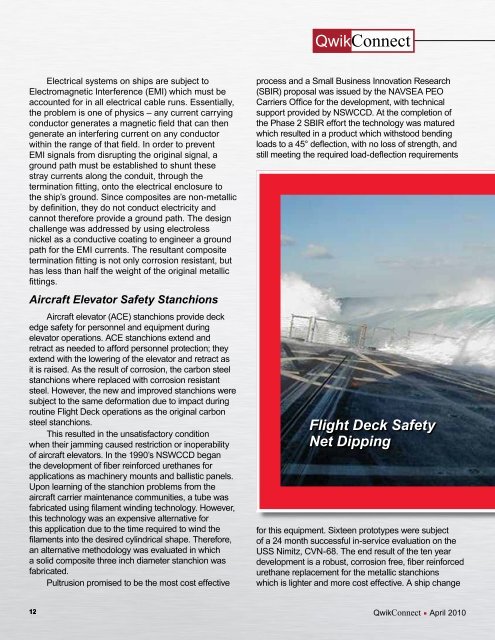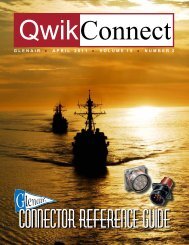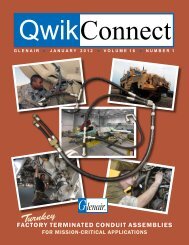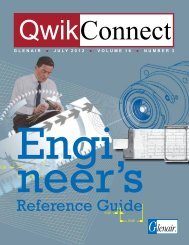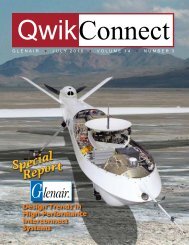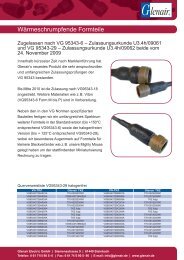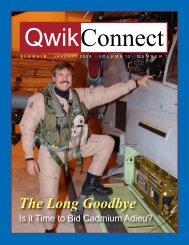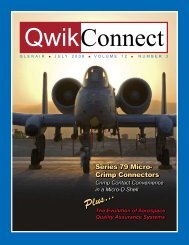April 2010 - Glenair, Inc.
April 2010 - Glenair, Inc.
April 2010 - Glenair, Inc.
You also want an ePaper? Increase the reach of your titles
YUMPU automatically turns print PDFs into web optimized ePapers that Google loves.
Electrical systems on ships are subject to<br />
Electromagnetic Interference (EMI) which must be<br />
accounted for in all electrical cable runs. Essentially,<br />
the problem is one of physics – any current carrying<br />
conductor generates a magnetic field that can then<br />
generate an interfering current on any conductor<br />
within the range of that field. In order to prevent<br />
EMI signals from disrupting the original signal, a<br />
ground path must be established to shunt these<br />
stray currents along the conduit, through the<br />
termination fitting, onto the electrical enclosure to<br />
the ship’s ground. Since composites are non-metallic<br />
by definition, they do not conduct electricity and<br />
cannot therefore provide a ground path. The design<br />
challenge was addressed by using electroless<br />
nickel as a conductive coating to engineer a ground<br />
path for the EMI currents. The resultant composite<br />
termination fitting is not only corrosion resistant, but<br />
has less than half the weight of the original metallic<br />
fittings.<br />
Aircraft■Elevator■Safety■Stanchions<br />
Aircraft elevator (ACE) stanchions provide deck<br />
edge safety for personnel and equipment during<br />
elevator operations. ACE stanchions extend and<br />
retract as needed to afford personnel protection; they<br />
extend with the lowering of the elevator and retract as<br />
it is raised. As the result of corrosion, the carbon steel<br />
stanchions where replaced with corrosion resistant<br />
steel. However, the new and improved stanchions were<br />
subject to the same deformation due to impact during<br />
routine Flight Deck operations as the original carbon<br />
steel stanchions.<br />
This resulted in the unsatisfactory condition<br />
when their jamming caused restriction or inoperability<br />
of aircraft elevators. In the 1990’s NSWCCD began<br />
the development of fiber reinforced urethanes for<br />
applications as machinery mounts and ballistic panels.<br />
Upon learning of the stanchion problems from the<br />
aircraft carrier maintenance communities, a tube was<br />
fabricated using filament winding technology. However,<br />
this technology was an expensive alternative for<br />
this application due to the time required to wind the<br />
filaments into the desired cylindrical shape. Therefore,<br />
an alternative methodology was evaluated in which<br />
a solid composite three inch diameter stanchion was<br />
fabricated.<br />
Pultrusion promised to be the most cost effective<br />
QwikConnect<br />
process and a Small Business Innovation Research<br />
(SBIR) proposal was issued by the NAVSEA PEO<br />
Carriers Office for the development, with technical<br />
support provided by NSWCCD. At the completion of<br />
the Phase 2 SBIR effort the technology was matured<br />
which resulted in a product which withstood bending<br />
loads to a 45° deflection, with no loss of strength, and<br />
still meeting the required load-deflection requirements<br />
Flight■Deck■Safety■<br />
Net■Dipping<br />
for this equipment. Sixteen prototypes were subject<br />
of a 24 month successful in-service evaluation on the<br />
USS Nimitz, CVN-68. The end result of the ten year<br />
development is a robust, corrosion free, fiber reinforced<br />
urethane replacement for the metallic stanchions<br />
which is lighter and more cost effective. A ship change<br />
12 QwikConnect n <strong>April</strong> <strong>2010</strong>


